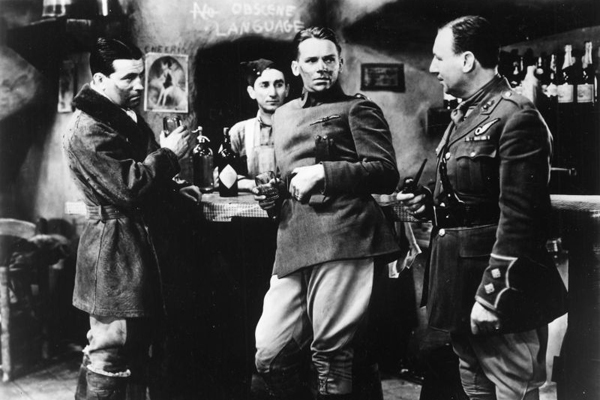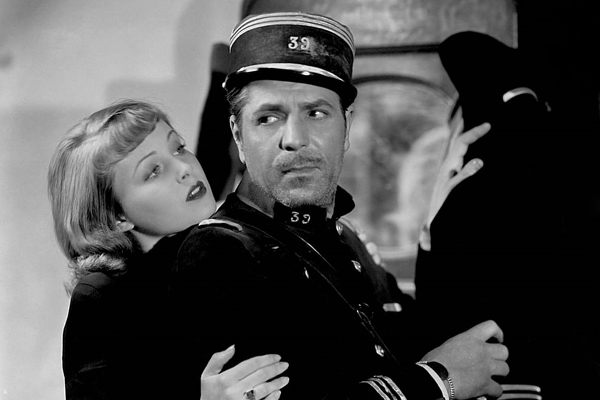The Machine War
This reflection on a pair of World War I movies by Howard Hawks is presented in conjunction with a complete Hawks retrospective at Museum of the Moving Image, from September 7-November 10, 2013. The Dawn Patrol screens on Saturday, October 19, at 2:00 p.m., and The Road to Glory shows on Sunday, November 3, at 5:00 p.m.
Howard Hawks enlisted in the Air Corps with five of his friends in 1917. By the time he started shooting The Dawn Patrol in 1930, they had all died in the cockpit, either in WWI or from accidents afterward. Hawks never saw wartime action himself, having served as a stateside flying instructor, but he thrived on the stories that returned from the trenches, including those recounted by Irvin S. Cobb, who told scenarist John Monk Saunders about a death-defying group of British flyboys. Their story turned into The Dawn Patrol, Hawks’s first sound feature. It portrays the war machine as an efficient meat grinder for young flesh, for which armies had an unending supply. Just as the production was starting, Howard’s brother Kenneth died in a stunt flying accident. The Dawn Patrol is haunted by all these passings, as is its veritable remake, The Road to Glory (1936), which replaces aerial dogfights with trench warfare. Both films structure WWI as an unending assembly line of death, with the soldiers stuck in its loop, the only way to stay sane by focusing on their work.

The Dawn Patrol
It is a theme that recurs throughout Hawks’s movies, although he will depart
further and further from historical reality in pursuit of it. The same idea
recurs in Only Angels Have Wings, but
transplanted to the made-up South American city of Barranca. These later films
have a clubhouse feel, as if Hawks could finally create his ideal world without
the intrusion of society. This isolation is already present in The Dawn Patrol, which takes place almost
entirely in a flyers’ canteen, in which ace Dick Courtney (Richard Barthelmess)
holds court with his pal Scotto (Douglas Fairbanks, Jr.) and a rotating cast of
wet behind the ears cannon fodder. Courtney used to be best pals with his
superior Major Brand (Neil Hamilton), but stress has worn them down to
irritable nubs. Their lives are a succession of grim rituals. After a mission,
Brand waits to hear the roar of returning Spitfire plane engines, counting them
as a way to track casualties. Courtney then erases the absent fliers’ names
from the bar chalkboard. This is their daily routine until both men are
promoted, and Courtney has to be the one to grin and bear it while his men die.
John Monk Saunders, like Hawks, was a flight instructor during WWI, and never
got over his failure to fight in the war. After hearing news of the Armistice,
Saunders went “out alone onto the airfield and wept, his head resting on the
wing of his plane.” Robbed of a heroic death, he started documenting those of
others, becoming steeped in flyboy lore. He documented these stories in popular
newspaper articles, which led to him writing the scenario for William Wellman’s
Wings (1927), the winner of the first Best Picture Oscar, and a novel about
Lost Generation veterans, Single Lady (1931),
which Hollywood adapted into The Last
Flight (1931). His wife Fay Wray described him as a man “who wanted to live
dangerously and die young”, which he accomplished by hanging himself at the age of 44.
In 1930 Saunders was still a hot commodity, however, so his story was picked up
by First National, to be distributed by Warner Brothers. In a bit of
professional gamesmanship, Hawks began hiring the technical team from Howard
Hughes’ Hell’s Angels, which had
recently wrapped, including Elmer Dyer, the chief aerial cameraman. Hughes was
incensed, and started buying up any avialable WWI planes and submitting
copyright infringement claims, all of which came to naught. He even sent a
lackey to steal their screenplay, which caused First National to file a
restraining order against Hughes. Despite these dirty tricks, both films were
released within three months of each other and became sizable hits.
In Saunders’ tale, Courtney and Brand do the job so they do not have to think
about the job, more comfortable in the planes than on land. Courtney and Brand
are haunted, skittish and jumpy. When booze and pills are not enough to stop
their minds from working, they use music. Hawks had already ran tests to shoot
with sound on Trent’s Last Case (1929),
but Fox had not negotiated talkie rights when they licensed the E.C. Bentley
mystery story. So it ended up as his
final silent, but gave him a rough technical knowledge of how to proceed on The Dawn Patrol. He encouraged the cast
to underplay, and Barthelmess’ face is an immobile mask, his dialogue delivered
in reluctant exhales. Hawks creates a soundcape of decay, whether it is his
actor’s tremulous line readings or plane engines cutting out. He also displays
an immediate interest in the dramatic power of musical sequences, seen later to
profound effect in everything from To
Have and Have Not to Ball of Fire.
After another devastating mission, the flight crew retires to the bar for their
nightly forgetting ritual. The record is spinning a big band tune, the names
are erased off the board, and drinking commences. Hawks, never known for his
elaborate camera movement, captures the revelry in a lateral tracking shot
encompassing the whole canteen. Then he pushes in slightly, with Courtney and
Scotto in the background tippling, while a mourning flier sits disconsolate in
the fore. Hollister (Gardner James) lost his best friend, and has been
proceeding in a fog, operating purely on habit. Some unknown soldiers stop the
record and start singing the bitterly ironic song, “Stand To Your Glasses
Steady”, adapted from the 19th century poem “The Revel” by
Bartholomew Dowling. Hawks learned it from his brother Ken, and the scene acts
as a memorial for those who have died both on and off-screen: “So stand by your glasses steady/This world
is a world of lies/Here’s health to the dead already/And hurrah for the next
man who dies.”
Hawks and William Faulkner attempted to develop another fatalistic war story in
1932. MGM purchased the rights to Faulkner’s short story “Turn About” at Hawks’s
request. It concerned the doomed WWI friendship between an American pilot and
two British torpedo boat operators. Irving Thalberg approved the script,
written by Faulkner, but a week later studio vice president Eddie Mannix
informed Hawks that the story had to be transformed into a vehicle for Joan
Crawford. There were no female characters in the script, so Faulkner rushed
revisions to shoehorn in Crawford’s ambulance driver. Re-titled Today We Live, it is a compromised and
unbalanced work.

The Road to Glory
Faulkner and Hawks had a more agreeable collaboration on The Road to Glory, which Hawks shot in 1936 for Darryl Zanuck at 20th Century Fox. With the same cyclical structure as The Dawn Patrol, also used to comic ends in Twentieth Century, it focuses on a platoon of French soldiers led
by Captain Paul LaRoche (Warner Baxter). As nerve-jangled as the The Dawn Patrol’s Brand, with half his
troops routinely cut down, he finds comfort in the ministrations of nurse
Monique (June Lang), who pities the aging officer but cannot bring herself to
love him. Lieutenant Michel Denet (Fredric March) is the one who captures her
affections, but must work with LaRoche to keep their infantryman alive in their
deployment to the trenches. Eventually Denet will take LaRoche’s place of
leading men to their makers.
Zanuck purchased the rights to the French WWI film Les Croix de Bois (Wooden
Crosses). He had no interest in the film itself, but wanted to re-purpose
the spectacular battle footage. He engaged Hawks to come up with a story to
surround the action, and he tossed out his variation on The Dawn Patrol. Joel Sayre was brought in to write the script, but
then Hawks heard that Faulkner’s brother Dean had been killed giving a flying
lesson. Faulkner was grieving and strapped for cash while completing Absalom, Absalom, so Hawks hired him to
work with Sayre on the screenplay. He agreed, and hashed out a treatment that
soon went before the camera. The atmosphere is thick with fog, spaces are made
unnavigable and claustrophobic. In the front-line scenes, Hawks packs the frame
with soldiers, and uses off-screen sound to stand-in for the invisible enemy.
As the returning plane engines indicated casualties in The Dawn Patrol, it is the thump of shovels hitting soil that
indicates mortality in The Road to Glory.
In the film’s centerpiece, a skittish enlistee hears a repeated low noise – it
is the Germans tunneling underneath them to plant a bomb. The thump repeats like
a metronome, ticking off the final minutes of their lives. LaRoche refuses to
evacuate because it would expose them to munitions and reveal all of their
positions. So they are forced to sit and sweat until their replacements arrive.
The sound is their salvation, if it stops that means an explosion will come
soon after. So they pray for the Germans to keep working until their
replacements arrive to take on the burden. Timing and luck keep LaRoche’s group
alive, as another platoon trudges in to take their place. In a long shot Hawks
captures the two lines of men, one headed for leave, the other into the shadow
of death. Soldiers are a replaceable commodity, the men unindividuated masses
whose lives are lost and saved by vagaries of shift schedules.
Warner Baxter seems to model his dead-eyed commander after Barthelmess’
somnambulistic performance in The Dawn
Patrol, a man who’s seen so much violence he starts to act with the slow
stagger of a re-animated corpse. Still a dependable leader from sheer force of
habit, his body begins to break down, as if from the sheer weight of what he
has witnessed. His character goes out in a melodramatic blaze of glory, but it
is clear he had perished long before this last heroic act.
Hawks would be loathe to kill of his main characters in later years, and he
kept them alive by disconnecting them from the chaos of the wider world.
Whether it is Barranca in Only Angels
Have Wings or the African safari in Hatari,
he moved his beloved clubhouses out of harm’s way. In the 1930s, still
personally affected by the horrific death toll of WWI, sacrifices had to be
made. With The Dawn Patrol and The Road to Glory Howard Hawks announced
himself as a fellow traveler in The Lost Generation. ![]()
LATEST ARTICLES
-20140814-173707-thumb3.jpg)
Fighting Words
by Imogen Sara Smith
posted August 12, 2014

Fighting Words, Part 2
by Imogen Sara Smith
posted August 20, 2014

On the Margins: The Fil…
by Andrew Chan
posted August 12, 2014

Robin Williams: A Sense…
by David Schwartz
posted August 12, 2014
 The Machine War
The Machine War
THE AUTHOR
R. Emmet Sweeney writes a weekly column for Movie Morlocks, the official blog of Turner Classic Movies. He has also contributed to Film Comment, Time Out Chicago and The Believer.
More articles by R. Emmet SweeneyAuthor's Website: Movie Morlocks

